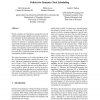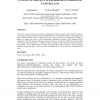287 search results - page 33 / 58 » Reducing Power in High-Performance Microprocessors |
OSDI
2000
ACM
15 years 1 months ago
2000
ACM
Pocket computers are beginning to emerge that provide sufficient processing capability and memory capacity to run traditional desktop applications and operating systems on them. T...
105
click to vote
MICRO
2000
IEEE
14 years 11 months ago
2000
IEEE
High-performance microprocessors are currently designed to exploit the inherent instruction level parallelism (ILP) available in most applications. The techniques used in their de...
101
click to vote
MICRO
2002
IEEE
14 years 11 months ago
2002
IEEE
On-chip caches represent a sizeable fraction of the total power consumption of microprocessors. Although large caches can significantly improve performance, they have the potentia...
CORR
2010
Springer
14 years 12 months ago
2010
Springer
Now a days, power has become a primary consideration in hardware design, and is critical in computer systems especially for portable devices with high performance and more functio...
ISCA
2008
IEEE
15 years 6 months ago
2008
IEEE
Server storage systems use a large number of disks to achieve high performance, thereby consuming a significant amount of power. In this paper, we propose to significantly reduc...


